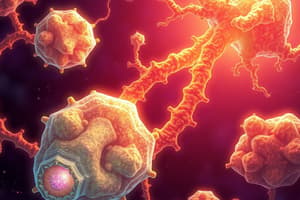Podcast
Questions and Answers
What is the primary function of galactokinase in galactose metabolism?
What is the primary function of galactokinase in galactose metabolism?
- To convert UDP-galactose back to galactose-1-phosphate
- To phosphorylate galactose to galactose-1-phosphate (correct)
- To hydrolyze lactose into glucose and galactose
- To transfer UMP to glucose-1-phosphate
Which enzyme catalyzes the formation of UDP-galactose from galactose-1-phosphate?
Which enzyme catalyzes the formation of UDP-galactose from galactose-1-phosphate?
- Glucomutase
- Galactosyl transferase
- Galactose-1-phosphate uridyl transferase (correct)
- Lactase
What must happen to galactose-1-phosphate before it can enter the glycolytic pathway?
What must happen to galactose-1-phosphate before it can enter the glycolytic pathway?
- It must be reduced to glucose-1-phosphate
- It must be phosphorylated by ATP
- It must be converted to UDP-galactose (correct)
- It must be converted to galactose
What is one potential outcome of UDP-galactose in metabolic pathways?
What is one potential outcome of UDP-galactose in metabolic pathways?
What is the fate of glucose-1-phosphate after being produced during the formation of UDP-galactose?
What is the fate of glucose-1-phosphate after being produced during the formation of UDP-galactose?
What enzyme is responsible for the conversion of UDP-Galactose to UDP-Glucose?
What enzyme is responsible for the conversion of UDP-Galactose to UDP-Glucose?
What is the primary cause of Galactosemia?
What is the primary cause of Galactosemia?
What mechanism leads to the symptoms of Galactosemia?
What mechanism leads to the symptoms of Galactosemia?
What dietary intervention is recommended for patients with Galactosemia?
What dietary intervention is recommended for patients with Galactosemia?
What is the result of galactose accumulation in cells?
What is the result of galactose accumulation in cells?
What condition is associated with cataracts in Galactosemia?
What condition is associated with cataracts in Galactosemia?
What is the outcome regarding mental retardation in Galactosemia treatment?
What is the outcome regarding mental retardation in Galactosemia treatment?
Which molecule is formed when galactose is reduced inside cells?
Which molecule is formed when galactose is reduced inside cells?
Flashcards
Galactose Metabolism
Galactose Metabolism
The breakdown of galactose, a sugar found in milk, into usable energy. It involves a series of enzymatic reactions that convert galactose into glucose, which can be utilized by the body.
Lactase (Galactosidase)
Lactase (Galactosidase)
An enzyme that breaks down lactose (milk sugar) into glucose and galactose.
Phosphorylation of Galactose
Phosphorylation of Galactose
The initial step in galactose metabolism, where galactose is converted into galactose-1-phosphate using ATP as the phosphate donor.
UDP-Galactose
UDP-Galactose
Signup and view all the flashcards
Galactose 1-phosphate uridyl transferase
Galactose 1-phosphate uridyl transferase
Signup and view all the flashcards
UDP-Galactose-4-epimerase
UDP-Galactose-4-epimerase
Signup and view all the flashcards
Galactosemia
Galactosemia
Signup and view all the flashcards
Primary Cause of Galactosemia
Primary Cause of Galactosemia
Signup and view all the flashcards
Mechanism of Galactosemia
Mechanism of Galactosemia
Signup and view all the flashcards
Treatment of Galactosemia
Treatment of Galactosemia
Signup and view all the flashcards
Reversal of Symptoms in Galactosemia
Reversal of Symptoms in Galactosemia
Signup and view all the flashcards
Cataracts in Galactosemia
Cataracts in Galactosemia
Signup and view all the flashcards
Galactitol
Galactitol
Signup and view all the flashcards
Study Notes
Galactose Metabolism
- Galactose is derived from lactose (milk sugar)
- Lactose hydrolysis by lactase produces glucose and galactose
- Glucose enters glycolysis
- Galactose is phosphorylated to galactose-1-phosphate by galactokinase, using ATP as a phosphate donor
- Galactose-1-phosphate can't enter glycolysis. It needs to be converted to UDP-galactose.
- This conversion occurs via an exchange reaction involving UMP, transferring from UDP-glucose to galactose-1-phosphate, resulting in UDP-galactose.
- The enzyme that catalyzes this reaction is galactose-1-phosphate uridyl transferase.
- UDP-galactose can enter various synthetic pathways for glycoproteins and lactose.
- UDP-galactose also gets epimerized into UDP-glucose by UDP-galactose 4-epimerase.
- Galactosemia results from defects in galactose metabolism pathways.
Specific Objectives
- Students should be able to explain the metabolic pathway of galactose.
- Students should be able to discuss disorders in galactose metabolism.
Galactokinase Deficiency
- Rare autosomal recessive disorder
- Causes elevated galactose and galactosuria
- Galactitol accumulation can cause cataracts
- Treatment involves dietary restrictions.
Classic Galactosemia
- Autosomal recessive disorder (1 in 30,000 births)
- Deficiency in galactose-1-phosphate uridyltransferase (GALT)
- Accumulation of galactose-1-phosphate and galactitol in tissues like the liver, nerves, and lenses
- Leads to liver damage, developmental delays, cataracts, and mental retardation.
- Prenatal diagnosis and newborn screening are available.
- Treatment involves a galactose-free diet.
Cataracts in Galactosemia
- Occurs due to galactose accumulation, converting to galactitol in cells, causing osmotic swelling.
- The accumulation of galactose inside cells results in the formation of cataracts.
Studying That Suits You
Use AI to generate personalized quizzes and flashcards to suit your learning preferences.



